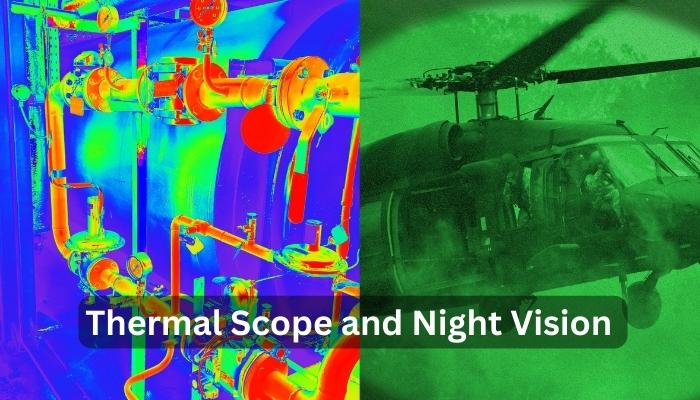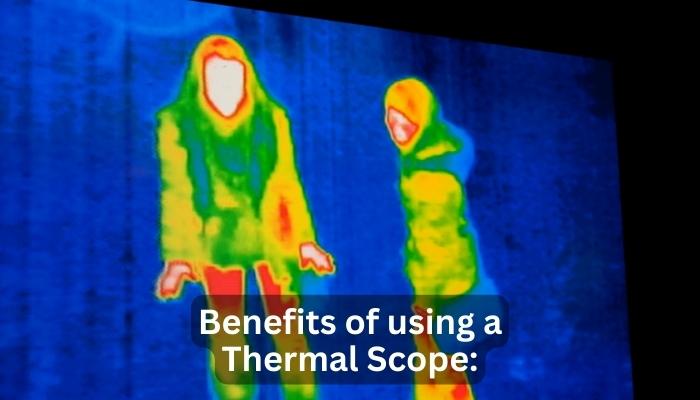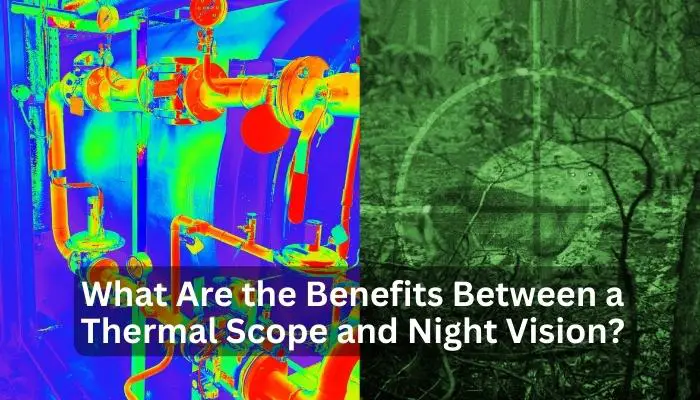What’s the difference between thermal imaging and night vision? and what are the benefits of using thermal scope and night vision? Keep reading until the article finishes
One lets you see in the dark, while the other gives you infrared thermal images of your surroundings, right? Not exactly! While both night vision and thermal scopes allow you to see in low-light conditions.
They are very different pieces of equipment with unique advantages that can be used to complement each other. The biggest difference between night vision and thermal imaging technology is their resolution and how they accomplish what they do. Now you can jump into the details.
Contents
- 1 What are Thermal Scope and Night Vision?
- 2 Benefits of using a Thermal Scope:
- 2.1 Infrared detectors are known as microbolometers
- 2.2 The only thing needed is temperature
- 2.3 The Observable Lens
- 2.4 View through the bush
- 2.5 Vision with a variety of characteristics
- 2.6 It’s Not Just for Scouts
- 2.7 Be using it During the daytime
- 2.8 Wildlife Population Preservation
- 2.9 Hunter Protection
- 3 Benefits of using Night Vision technology:
- 4 Which one should you choose?
What are Thermal Scope and Night Vision?

A thermal scope works with infrared light to generate images or thermograms. In thermography, an image of any object is captured or created through the emission of infrared radiation from the object. The combination of simple functionality along with infrared technology is present in a thermal scope.
Bright things indicate hot things, while cold things seem to be dark. For instance, non-living objects like water and buildings give off less heat than moving objects like humans, animals, cars, etc. thus, a thermal scope helps you detect objects near you. Thermal scopes are mostly used by hunters as it helps them detect animals and objects nearby.
On the other hand, Night vision is a technology that allows people to see in complete darkness and improves their eyesight in low-light situations. It becomes active when many components, particularly your pupils and retinas, collaborate within your eyes. When you need it, it may be really useful. This technology is vastly used by the Military and also by hunters.
Benefits of using a Thermal Scope:

Infrared detectors are known as microbolometers
A microbolometer is essentially a compactly built collection of heat sensors that are microscopic and have a sensitivity to infrared radiation with a wavelength of 7 – 14 m. The array is also extremely tiny in size, allowing it to fit easily on the microcontroller that controls it.
When the sensor detects infrared radiation, it raises the temperature of the individual components that detect it. With many components monitoring temperature changes, the microchip can transform radiation data into Temperature and create a picture as a result. The imagery created is smooth and high-resolution, thanks to the technology that allows the employment of a large number of components in a single scope.
The main benefit of this device over traditional photon detectors is that it does not require any cooling and can outperform them in terms of performance. In addition to producing sharper pictures, the degree of maintenance required is far less frequent and less expensive when compared to a standard photon detector. As a result, the initial investment in a thermal imaging scope pays for itself in terms of product life.
The only thing needed is temperature
Thermal imaging devices, as opposed to night vision, do not require any light to function. Thermal imagers, on the other hand, detect minor changes in temperature and use those differences to build a picture. Everything, whether a deer or a rock, emits heat energy, which the smart sensors turn into a dazzling image.
The sensors on a thermal imager may detect differences as tiny as 0.01 degrees, allowing it to assess whether a set of tracks is fresh. Even the slightest blood droplets can be seen while following a newly shot animal.
The Observable Lens
Unless a high-quality lens is employed to bring the picture into focus, the microbolometer cannot capture anything. A germanium lens is used in the scopes of thermal imaging to provide an image of top-notch conditions. During the lens, magnification may be whatever you like; video monitoring can be set up for any size space.
View through the bush
Thermal imagers can “see past” certain barriers that would normally obscure your vision because they sense temperature variations. You won’t be able to scour through concrete with your new thermal device, but you will be able to notice a deer sneaking through a patch of tall grass.
Smoke and fog are also no match for thermal units, so if you’re piloting a boat through a foggy sound regularly, consider them both visual aids.
Vision with a variety of characteristics
There are currently a variety of useful accessories linked to thermal imaging scopes. This dramatically increases the lens’s and its user’s versatility. AMOLED panels that are resistant to frost and fog, high-resolution imaging, digital zoom feature, integrated Wi-Fi and Bluetooth option, integral storage with video recording, and many other aspects are available.
The leading security systems, video monitoring systems, and CCTV on the market are all designed to function admirably in indoor and outdoor settings. Keeping your perimeter secure will be an easy task. With so many resources to help you improve your vision,
It’s Not Just for Scouts
Though it had experimented with night vision technology since World War II, the American Army first used night-capable riflescopes in the Vietnam War. It was provided to perimeter guards and snipers. The sniper was called ‘starlight scope.’ Those scopes weren’t famed for their accuracy since they used a mechanical zero that required shifting the entire six-pound instrument to adjust the crosshairs.
Modern devices are much slimmer, and the thermal cores give significantly improved imaging. Accuracy has substantially increased, and many units can be sight-in with a single shot.
Be using it During the daytime
Thermal imagers bring night vision into the light of day. Because they utilize Temperature rather than light, you’ll see the same image whether you’re in the brightest sunlight or the deepest darkness. This means you won’t have to switch optics and risk losing your zero if you want to go to the range or do some predator calling during the day.
Wildlife Population Preservation
Thermal technology has been utilized by wildlife law enforcement to assist reduce nighttime poaching and unlawful hunting, which benefits all sportsmen and game populations. Kenya is one example of how effective thermal technology may be in combating poaching. This African country has lost a large number of elephants to poachers.
Due to thermal technology, game rangers attempting to stop the flood of illicit ivory were able to apprehend over a hundred poachers in a short period in one region of Kenya that had been particularly ravaged by poaching. But the conservation advantages aren’t limited to Africa; in the United States, thermal technology has helped wildlife officials lessen the toll poachers impose on animals, protecting our sport’s future.
Hunter Protection
It’s great to have a thermal camera on hand in these situations, as a fast scan of the surrounding area gives you some peace of mind that you won’t run across a giant bear on your way out to do your own thing. However, thermal gears defend against predators in more than one manner. If you’ve ever hunted deer on public land during gun season, you’ve probably learned how private your secret hunting place is.
Having a portable thermal in your pocket allows you to determine whether or not other hunters are establishing a perimeter, which may be quite useful. You can’t tell if the man who put up a tent a few yards away from you is in gun safety, but you’ll know they’re out there if you use a thermal. And if you’re all prepared to sweet talk the gobbler you know is across the field only to discover another hunter lurking beneath the roost tree, you may count your losses and bail.
Benefits of using Night Vision technology:

Light Enhancing, Temperature Sensing
There are two types of night vision equipment: image intensification systems and thermal devices. Even when the night seems entirely dark, the moon and stars radiate near-infrared light. This light is amplified to detectable levels by a night vision gadget.
Light, which consists of photons, is turned into electrical energy and then accelerated via a narrow disk known as a microchannel plate. As the transformed photons impact a phosphorous screen as electrons, they are seen through a green eyepiece.
It is quite efficient even in winter
When seen via an infrared instrument in the winter, you will notice varied hues of gray or black, with the whitest segments denoting those emitting the greatest heat.” According to some studies, when winter approaches in Afghanistan, infrared technology will become more efficient as the temperature disparity between the body and the outside temperature increases.
However, it is stated that contrast does not always improve infrared vision and that once the snow falls, the reverse is true.
Besides Military and Aircraft Usage, it is useful in many other sectors
Infrared sensors may be valuable for ground troops and pilots’ eyesight and for detecting recent footprints or tire tracks that may still be radiating heat. This is very crucial for hunters as they will be able to know what or who just passed by or is at the location. Even freshly touched things, such as a desk or door, might reveal indications of recent activity.
In addition to military uses, infrared technology has proven effective in a variety of civilian areas. Law enforcement uses it to identify criminals working at night, border patrol uses it to monitor for illegal crossings, ranchers use it for hunting nocturnal predators like coyotes, and drivers in certain specially-equipped autos use it for superior night vision.
The technique may also aid in creating a thermal picture of a home to detect leaks and enhance insulation.
Which one should you choose?
The technology of thermal imaging gives the ethical hunter a major edge while pursuing wild games. However, they do not take the place of the requirement to be stealthy, silent, and wind-aware. They also do not minimize the necessity to be aware of the terrain and are dedicated to the practice of genuine hunting techniques. Thermal imaging rifle scopes, monoculars, and binoculars do not make night hunting simpler, but they do enhance your chances.
On the other hand, Night Visions have a compact system where no specific ability is necessary. While in terms of durability, they are quite similar to each other. Thermal vision is now as strong and long-lasting as night vision. Both night vision and thermal vision can endure recoil up to 30 calibers.
For many hunters, price is also a major consideration. While thermal detection holds a higher ranking, it is way costlier than night vision. Thermal imaging is the latest and most advanced technology. This explains the higher cost which goes into assembling these. On the other hand, Night vision has been available after WWII, and the availability has reached extensibility and offers a much lower price.
All in all, both thermal imaging and night vision scopes have advantages and disadvantages. If the former is too pricey, you can register the thermal monocular. It’s no surprise that this is a little more expensive alternative, but you may feel confident in giving it a shot. Second, while using night vision, the thermal monocular may simply be utilized to maintain track of the quarry.
Read also: HOW DOES A MAGNIFYING GLASS WORK

